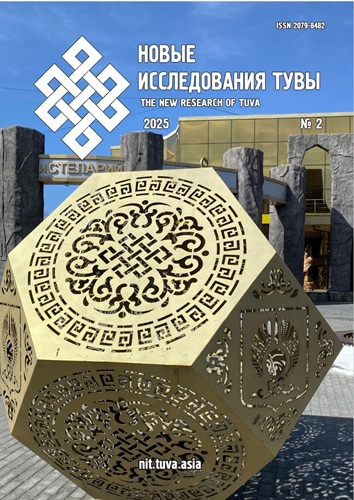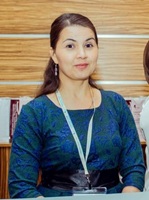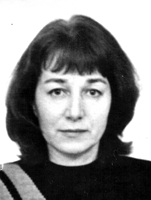The lexeme ai (moon, month) in Old Tatar written texts (XIII — early XIX century)
DOI:
https://doi.org/10.25178/nit.2025.2.22Keywords:
ay; Moon; Tatar language; Old Tatar written language; Turkic languageAbstract
The article presents an analysis of the lexeme “ay” (moon, month), which holds significant importance in the Old Tatar written language. Since ancient times, in the Tatar linguistic worldview—as in those of all peoples of the world — the Moon has been perceived as a special celestial object, a cosmic symbol of earthly life in all its forms. The choice of this word is motivated by its widespread usage in the Old Tatar language and its rich semantic potential as reflected in written texts from the 13th to the early 19th century. The source base consists of twenty-four written monuments from the specified periods.
The study reveals that in the analyzed Old Tatar written sources, ay is one of the most consistent and enduring images. The analysis of the linguistic material shows that the lexeme “ay” (moon, month), when used in a figurative sense, demonstrates remarkable semantic diversity.
The results of the study indicate that different authors employ the semantic resources of this lexeme in various ways in their works. The uniqueness of the word’s semantics lies in the fact that nearly all dictionary meanings of this lexeme offer wide opportunities for its use in symbolic contexts. The figurative use of the word ay in Old Tatar written monuments primarily actualizes the following meanings: celestial body, source of light, period from one new moon to the next, symbol of health and healing, symbol of beauty, among others — all of which remain relevant today. These lexical meanings have been preserved up to the present time.
References
Anisimov, R. N. (2016) Lexemes denoting celestial bodies and the celestial sphere in Yakut phraseology. In: Cultural Heritage of Traditional Communities in the Context of World Civilization: Problems of Translation and Intercultural Dialogue. Proceedings of the All-Russian Scientific Conference with International Participation Dedicated to the 60th Anniversary of M.K. Ammosov NEFU Yakutsk November 10–11 2016. Ed. by A. A. Nakhodkina. Yakutsk, Publishing House of NEFU. 292 p. Pp. 105–112. (In Russ.)
Bashirova, I. B. (2018) Theory of the Turko-Tatar Literary Language. Kazan, TӘһSI. 316 p. (In Tatar)
Blagova, G. F. (1994) Babur-name: Language, Text Pragmatics, Style. On the History of the Chagatai Literary Language. Moscow, Vostochnaya Literatura RAN. 404 p. (In Russ.)
Valieva, M. Z. (2021) Lexical means of expressing the category of time in written sources of the 17th–18th centuries. Mir nauki. Sotsiologiya Filologiya Kulturologiya, vol. 12, no. 4. (In Russ.)
Burnakov, V. A. and Tsydenova, D. Ts. (2013) The moon in the traditional worldview of the Khakas. Vestnik NSU. Seriya: Istoriya Filologiya, vol. 12, issue 3, pp. 267–279. (In Russ.)
Zakiev, M. Z. (1995) Tatars: Problems of History and Language. Kazan: Printing Association named after K. Yakub. 464 p. (In Russ.)
Kadirova, E. Kh. (2010) Cosmonyms in Turko-Tatar written monuments. In: Proceedings of the XII International Scientific Conference “Onomastics of the Volga Region”. Ed. by I. A. Gilyazov. Kazan, Otechestvo. 443 p. Pp. 334–336. (In Russ.)
Kara-ool, L. S. (2015) The concept “month” in the Tuvan language: winter months. Filologicheskie nauki. Voprosy teorii i praktiki, no. 12(54): in 4 parts. P. 4. Pp. 93–97. (In Russ.)
Ketenchiev, M. B., Dodueva, A. T. and Khubolov, S. M. (2019) Names of the months in the Karachay-Balkar language. Vestnik Cherepovetskogo gosudarstvennogo universiteta, no. 6, pp. 109–117. (In Russ.)
Kuzmina, A. A. (2023) The concept “moon” in the Yakut linguistic worldview. Vestnik NSU. Seriya: Lingvistika i mezhkulturnaya kommunikatsiya, no. 21 (3), pp. 106–117. (In Russ.) DOI: https://doi.org/10.25205/1818-7935-2023-21-3-106-117
Nadzhip, E. N. (1989) Studies on the History of Turkic Languages of the 11th–14th Centuries. Moscow, Nauka. 281 p. (In Russ.)
Nuriyeva, F. Sh. (2004) Historical and Linguistic Conditions for the Formation of the Turko-Tatar Literary Language of the Golden Horde Period. Kazan, Kazan State University. 376 p. (In Russ.)
Sagdeeva, F. K. (2024) Mythical time in the language and consciousness of the Tatars (on the example of the words el (year), ay (month), atna (week)). In: National Languages and Interlingual Processes in the Modern World. Proceedings of the International Scientific and Practical Conference Dedicated to the 85th Anniversary of the Institute of Language Literature and Art named after G. Ibragimov of the Academy of Sciences of the Republic of Tatarstan. October 9–10 2024. Comp. by M. R. Bulatova et al. Kazan, IYALI. 492 p. Pp. 353–361. (In Russ.)
Bashirova, I. B., Nuriyeva, F. Sh. and Kadirova, E. Kh. (2015) History of the Tatar Literary Language (13th – early 20th century) vol. 1: Phonetics. Graphics: Writing Traditions Norm and Variability. Ed. by F. M. Khisamova. Kazan, TӘһSI. 696 p. (In Tatar)
Tenishev, E. R. (1987) On the language of the poem “Kyssa-i Yusuf” by Kul Gali. In: Poet-Humanist Kul Gali. Ed. by N. Sh. Khisamov. Kazan, Tatar Book Publishing House. 264 p. Pp. 133–137. (In Russ.)
Tenishev, E. R. (1997) Turkic written monument languages. In: Languages of the World: Turkic Languages. Ed. by E. R. Tenishev. Bishkek, Kyrgyzstan. 547 p. Pp. 35–46. (In Russ.)
Tenishev, E. R. (2006) Selected Works. Ufa, Gilem. 304 p. (In Russ.)
Khayrullin, R. Z. and Sharyafetdinov, R. Kh. (2022) Mythologism of astral images of the sun and moon in modern Tatar literature. Vestnik Mariiskogo gosudarstvennogo universiteta, vol. 16, no. 1, pp. 113–120. (In Russ.) DOI: https://doi.org/10.30914/2072-6783-2022-16-1-113-120
Khakov, V. Kh. (1999) Tatar Literary Language: Stylistics. Kazan, Tatar Book Publishing House. 302 p. (In Tatar)
Khakov, V. Kh. (2003) Language as a Mirror of History. On the Development of the Tatar Literary Language from the Ancient to the National Period. Kazan, Tatar Book Publishing House. 295 p. (In Tatar)
Khisamova, F. M. (2012) The Tatar Language in Russian Eastern Diplomacy (16th — Early 19th Centuries). Kazan, Tatar Book Publishing House. 405 p. (In Russ.)
Published
How to Cite
For citation:
Kadirova E. Kh., Valieva M. Z. and Sagdeeva F. K. The lexeme ai (moon, month) in Old Tatar written texts (XIII — early XIX century). New Research of Tuva, 2025, no. 2, pp. 365-377. (In Russ.). DOI: https://doi.org/10.25178/nit.2025.2.22
Issue
Section

This work is licensed under a Creative Commons Attribution-NonCommercial 4.0 International License.

Author(s) license holder(s) grant rights for their work to the journal (grantee of a license) under the simple non-exclusive open license in accordance with Art. 1286.1 «Open license for a research work, work of literature or fine arts», Civil Code of the Russian Federation.
New Research of Tuva publishes articles under the Creative Commons Attribution-NonCommercial license (CC BY-NC).
Since it is an open license, author(s) reserve the right to upload the article to their institutional repository, submit it to another journal (if it allows republications), or republish it on their own website (in full, or in part).
However, several conditions apply here:
a) The republished version must always contain the name(s) and affiliation(s) of the author(s), the original title and the hyperlink to the original version on the New Research of Tuva website;
b) It must be in open access, free of charge, and no category of readers must be in any way whatsoever advantaged over general readership.
c) should the contribution be submitted elsewhere by its author(s) without substantial modification (30% or more of original text unchanged), the body of the article should contain a disclaimer that the original version was published in New Research of Tuva (with a link to the respective page)
The CC-BY-NC is a non-revocable license which applies worldwide and lasts for the duration of the work’s copyright.











